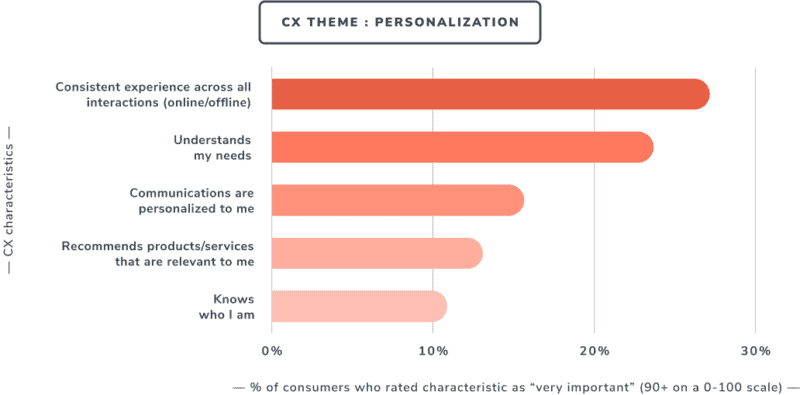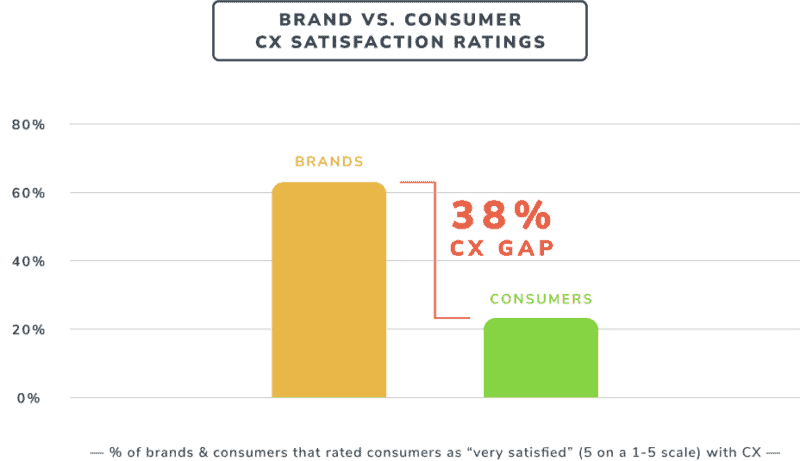Personalized Customer Experience Means Going Beyond the Surface

What does good personalized customer experience (CX) look like? According to consumers, it’s both perceptive and persistent.
We surveyed hundreds of consumers as part of our inaugural CX IQ Index, digging into what drives positive customer experiences and how today’s brands measure up.
Unsurprisingly, personalization was highlighted as a key component of solid CX. The vast majority of consumers say they’re more likely to buy from brands that prioritize personalized engagement, after all.
But our research also revealed the importance of diving deeper — and doing so across channels. The personalization characteristics consumers are most likely to say are “very important” to CX are all about providing consistent omnichannel experiences in a way that recognizes their needs.
Read on to learn how you can go beyond the surface and develop a personalized customer experience strategy that drives results.

Personalized Customer Experience Means Going Beyond the Surface
Focus on the “What,” Not Just the “Who”
The two personalization characteristics most likely to be rated “very important” (90 or higher on a 0-100 scale) to customer experience were “consistent experience across all interactions (online/offline) (26%) and “understands my needs” (23%).
While many brands believe personalized communications and product recommendations based on past purchases are enough to scratch the personalization itch, consumers have made it clear they demand something more. It’s not about proving you know who they are — it’s about what you do with that information.
In short, consumers want brands to anticipate their needs and follow up accordingly on their preferred channels — no matter when, where or how often they switch between them.
Having unified, accurate customer data that provides a comprehensive view of individual customers is essential to accomplishing this. But consumers aren’t concerned with the behind-the-scenes requirements so much as how those efforts manifest during the customer journey.
With the deprecation of third-party data right around the corner, many brands are scrambling to determine how they can solve for anonymous audiences — and rightfully so. But knowing who your customers are is only step one. Showing your customers you know what they need — and delivering it at the right time and place — is what moves the needle.

Brands Struggle With Personalized CX Across Industries
As we’ve highlighted before, modern brands are struggling to close the customer experience gap — and a lack of digital marketing personalization capabilities is contributing to the challenge.
Among the 350 businesses surveyed as part of the 2022 CX IQ Index, 61% said their customers are “very satisfied” (5 on a 1-5 scale) with customer experiences and interactions to get information, make a purchase or resolve an issue. However, only 23% of consumers said the same.
The disconnect between what businesses perceive — and how consumers view business performance — carries over into personalization.
For example, 34% of media & publishing brands rate themselves as “very strong” (90 or higher on a 0-100 scale) when it comes to providing consistent experiences across all online and offline channels. But only 24% of media & publishing consumers agree.
And while 54% of financial services brands say they’re “very strong” as it relates to understanding customer needs, only 34% of financial services consumers concur.
Without the right personalization capabilities — including tools that will help customer-facing teams support hyper-segmentation marketing, generate predictive insights and orchestrate experiences across all relevant channels — brands will continue to come up short.
See how Condé Nast personalizes marketing campaigns for its subscribers in the video below:
Personalized Customer Experience is Built on Accessibility, Analysis & Activation
More brands are investing in customer data to provide tailored, highly relevant CX — and the customer data platform (CDP) market is booming because of it. In fact, nearly 90% of brands say they’ve either already deployed a CDP or plan to in the future.
But simply purchasing a CDP isn’t a silver bullet for personalization — effective solutions must offer:
Accessibility
Everyday business users — such as marketers, salespeople and customer service representatives — need to be able to quickly get their hands on valuable customer insights without being forced to rely on technical assistance that slows down speed to market. Intuitive user interfaces for accessing customer data not only boost business efficiency, they stop IT teams from being overburdened with requests.
Analysis
Business teams must be able to segment customers and leverage predictive analytics, whether for generating next-best-action recommendations or identifying the behaviors and preferences of specific audiences. They must also be able to automate this process to do it at scale.
Activation
Business users require a way to operationalize customer insights into impactful experiences on both digital and offline channels. Customer intelligence won’t count for much without the ability to quickly and easily take action on it, whether via multi-step customer journeys or triggered real-time customer experiences.
Consumers have made themselves loud and clear: They don’t want cookie-cutter personalization, they want brands to acknowledge and cater to their unique needs on their channels of choice.
Now it’s up to brands to empower their people and processes with the right technology. Make sure you have the right tool for the job.
Learn More About Personalized Customer Experience
Download the 2022 CX IQ Index to learn more about the role of personalization in meeting your CX goals. Contact one of our experts to learn how ActionIQ can help.





